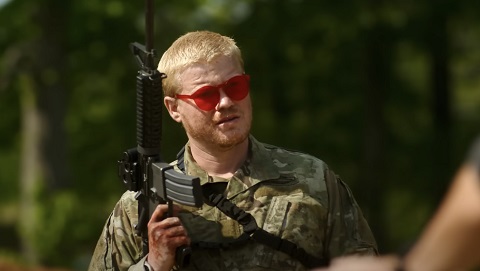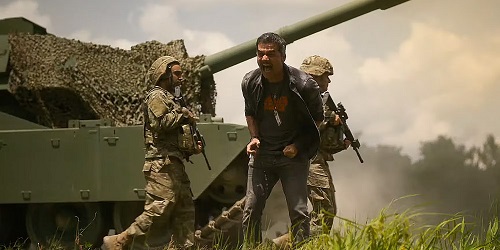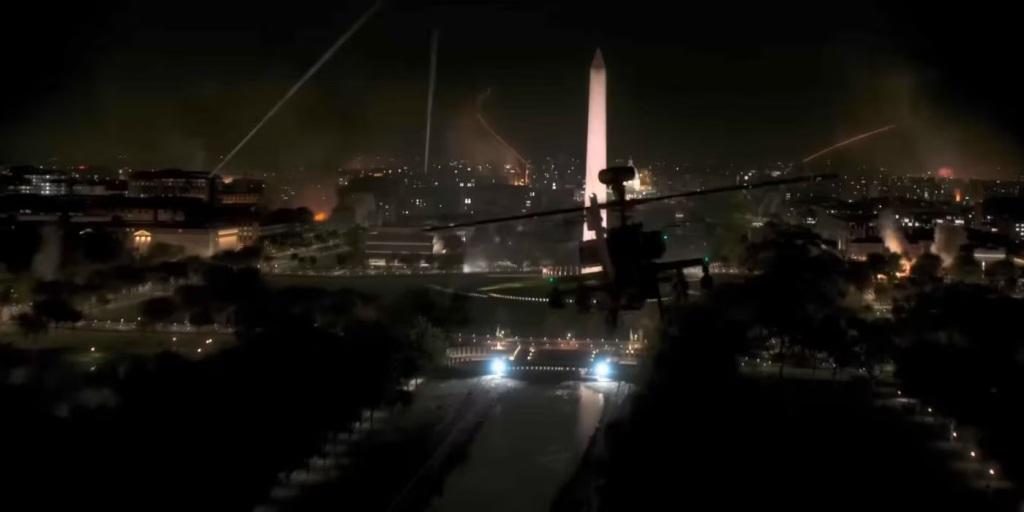Alex Garland’s Civil War is a pulse-pounding, eye-popping masterpiece from start to finish. The Londoner has seen this country’s heart, which is not difficult right now from that distance, and brought it to screen in such accuracy that many Americans still cannot recognize it.
New York City, the near future- the president of the U.S. (Nick Offerman) has secured a third term in office, causing three groups of states to secede from the union, most notable being the Western Forces of California and Texas. The president starts a war to keep the union together, and despite his constant claims of being on the cusp of victory, the W.F. is laying siege to Charlottesville, Virginia, from where they will advance to Washington D.C. with little resistance. Though his death will certainly not end the directionless civil war that has suddenly fallen over the U.S., the president’s days are numbered.
Journalists have been declared enemies of the state and are reportedly being killed on sight at the capital, but knowing their window is closing, renowned war photographer Lee Smith (Kirsten Dunst), a rookie independent photographer who idolizes her and reporters from Reuters and The New York Times (Cailee Spaeny, Wagner Moura and Stephen McKinley Henderson) set out on a suicide mission to photograph and interview the tyrant before he is killed. Because the interstates have all been destroyed and Philadelphia is reportedly too dangerous to be within even 100 miles of, they take a circuitous, 1,000 mile-route around Pittsburgh and south to the front line.
Though he is unnamed and meant to capture a broader possibility of an American dictator, it’s not veiled at all that the president is meant to be Donald Trump. He is shown in the film’s first shot working himself up to increasingly outlandish claims – “some are already calling it the greatest operation in the history of military campaigns” – and rubbing his nose a little too frequently. He clings to the underside of the Resolute Desk like a cockroach who knows he will die as soon as he leaves office. He is compared to “weaker” dictators like Muammar Gaddafi and Benito Mussolini, who Trump has also been compared to by historians.

What’s most incisive is he, like Trump, appears to be a catalyst rather than any kind of leader. The details of how he installed himself for a third term and how this war began are kept deliberately vague, but everyone onscreen treats it as a foregone conclusion that it’s all the president’s fault, and he’s spoken of not with anger, but with exasperation. Outside of the Secret Service, no one on any side of conflict ever expresses support for him.
Garland got his first jolt of fame for writing 28 Days Later in 2002, a film of subtly broad scope that imagines a U.K. devastated by a zombie plague. Months after the 9/11 attacks, its scenes of a deserted, post-apocalyptic London with real landmarks in the background seemed shockingly possible. Now, when the Jan. 6 insurrection seems like it’s getting closer in hindsight instead of further, Civil War is a return to that sweeping exercise in set design, bringing us images of multiple blocks of the U.S. at a time devastated by war.
It’s a road movie, and it’s set on the road, the near-identical pit stops that dot this country and quickly become its recognizable backbone to those who travel it, malls, gas stations, towns of 2,000 that no one ever leaves. These are the settings that Garland defiles with destroyed military equipment and scattered corpses, all of which seem to be fresh – this film would certainly delight over decomposing bodies left in the sun for a couple of weeks, but it never does, and I think that’s intentional. Something seems to be on fire in every block. Gunshots from unknown combatants rattle across the night. Sleeping bags seem to be everywhere, as the already boiling-over housing crisis can’t have been helped by homes and apartment buildings actually being destroyed.
Perhaps the most shocking set is Manhattan, the invincible colossus where everyday life continues no matter what. Far from any military, the city roils with protests. Some blocks are packed with people, with riots around every corner, and others blocked off by the military are eerily empty. Army vehicles are sprinkled in the crush of downtown traffic. A pandemic here, an insurrection there, Ron Swanson ordering airstrikes on American citizens, nothing stops New York.

Contrarily, it’s an astonishingly beautiful film, one that astutely cuts to the core of romance for the country it is photographing self-destructing. Set mostly in Pennsylvania and West Virginia, but shot around Atlanta, the rolling green hills of this continent are marred by war, but not destroyed by it. It’s shot on 35mm film, so it’s got those bright, real greens of the Georgia forests, in chunky IMAX 1.85:1 aspect ratio, so it’s meant to be seen big – Civil War wants to feel as plausible as it can, so it’s designed to be tangible.
In the extended, astonishing climax in downtown D.C., all the monuments and 21st century hotels maintain their serene beauty even as a blizzard of gunfire drowns out all other noises and military convoys advance through the streets.
During the Jan. 6 insurrection, a lot of talking heads who’ve been on the air way too long clutched pearls about the sacred halls of democracy being defiled like never before, as if this weren’t a building where slavery was upheld for decades, Ronald Reagan spoke and Ted Cruz went to the bathroom, and in Civil War’s climax, when we see violence take the halls of a detailed recreation of the White House, the setting’s beauty and stateliness remains. Films have imagined White House invasions before, of course, but they’re usually about rightful presidents being taken hostage and the drama of protecting them. By the time Garland’s camera enters 1600 Pennsylvania Ave., most of what happens next is a foregone conclusion. The halls seem indifferent to the blood that fills them, sure that it will be washed away and a different administration will come back.
Garland has called Civil War a companion piece to his 2022 film Men, but it’s almost a moment-for-moment remake of his 2018 film Annihilation, which also follows a patchwork group on a journey into a familiar but corrupted rural America. We see similar sudden music cues and similar sets handled in similar ways. We see big, dramatic wide shots of new settings like the graffiti-covered football field where our group spends a night, and the distant wailing of a wounded soldier in a long, dark stairwell scene also recalls several moments in the prior film.

Journalism is the only profession designated in any U.S. founding document, and it’s fitting that in a movie about the nation’s imminent collapse, it is this gaggle of reporters, married to and still deeply in love with the nation’s founding ideals, who carry the memory of the country that used to be. The party has two in the primes of their careers, one reporter too old to make this journey who walks with a cane and one photographer in her early 20s unprepared for the horrors she is approaching, so there’s a lot of old bull-young bull tensions and resentments. One criticism has been for thin characterization, but these characters are journalists – their character is to observe at any cost, and the fact that they never make it about themselves is a mark of honor. They wear their credentials and “press” flack jackets proudly, knowing it could get them killed, but more than willing to die for the work they’ve done to get to this point and the principles they stand for.
In the same breath, it is the national press that has been exposed as passive and ineffectual during the Trump era, and Civil War is constantly bumping up against its protagonists’ refusal to do anything more than document the violence. Because they’re so active, they always seem like they’re going to come to the rescue, but that’s not how this works.
Perhaps another flaw is brevity. Civil War has noticeably few set pieces, many of which were shot in some roadside clearing near Atlanta. It’s hard to square the devastation we see with the idea that our group only encounters 109 minutes’ worth of problems, though the film is still a marathon at that runtime. The scope of this story could definitely support an extended cut.
There’s been plenty of complaining about the “poor timing” of this movie coming out as the 2024 election ramps up, but the film’s perfect timing is exactly the point – it even releases on April 12, the 163rd anniversary of the Battle of Fort Sumter. Civil War isn’t ripped from the headlines as much as it’s ripped directly from the subconscious of any American paying attention to the wave of white nationalism that has crested every four years since the Civil Rights movement took off, whether it is tied to the Republican Party and its Southern Strategy, its propaganda arm or the “lone wolf” white supremacist shootings that have become so frequent and similar they are now understood as a decentralized terrorist movement. The politics are very real. Both Trump, who clearly intends to install himself as president for life if possible, and Barack Obama have been mentioned as potential three-term presidents in the recent past. California and Texas, despite the hatred they claim for each other, have a great deal in common and have been cross-pollinating intensely in the ‘10s – the states already dominate national politics, and a sudden and overwhelming political alliance between them feels inevitable.
The locations are certainly not meant to be neutral. Charlottesville, the site of the 2017 race riot after which Trump called white supremacists in Klan and neo-Nazi gear “very fine people,” is the “front line” for most of the film, and Philadelphia, the nation’s original capital, is somehow even more dangerous than D.C., like the nation’s subconscious that even our war reporter heroes won’t approach. It played a central role in the 2020 election as well, though Garland wrote the film in 2020 before the election played out.

At $50 million production budget, Civil War represents indie distributor A24’s biggest investment to date, and the second IMAX rollout after last year’s Beau is Afraid. Nine years after Garland’s own Ex Machina, for which the now-iconic company took home its first Oscar, it still feels like watching the boutique little film shop that could, like counting a child’s milestones. That budget number is about a quarter of what Disney usually spends on its tentpoles these days, and as with many cheaper films in this era, the money is spent so much better on the extra expense of film stock, a surgically used helicopter budget and thorough location scouting.
Leopold Knopp is a UNT graduate. If you liked this post, you can donate to Reel Entropy here. Like Reel Entropy on Facebook and reach out to me at reelentropy@gmail.com.


Pingback: About that ‘Civil War’ AI marketing campaign | Reel Entropy